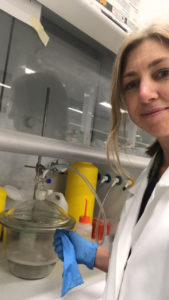
Dr Kim Johnson
Senior Research Fellow, La Trobe University
Field of expertise: Plant biology
In the time you have been working in your field, what impossible things have become possible?
When I first started working in plant biology sequencing of the DNA code (or genome) of the first plant was in the final stages of completion, having taken almost 10 years to complete. The idea that thousands of plant and animal genomes could be sequenced seemed impossible. Yet it is now possible to sequence a plant genome within a matter of weeks. This genetic information has provided an amazing amount of information about factors that control growth and development of plants and animals. In parallel, the impossible task of observing and measuring thousands of plants in a field to find those with the best features has now become possible with drone, satellite and other forms of imaging technologies. Bringing together information about the genetic and observable features of plants has made new breeding technologies possible and revolutionised Agriculture.
What impossible thing(s) are you working towards making possible, and why?
In 2050 the world population is expected to reach almost 10 billion. Feeding this population with nutritious foods that can be sustainably produced is a huge challenge. Together with researchers at the La Trobe Institute for Agriculture and Food i am working to increase the productivity of plants by understanding how they grow and develop. My work aims to understand how plants feel and respond to physical stress, such as touch, bending or internal pressure, a question that has remained impossible to answer for over 100 years. Plants can change their growth and body shape in response to stress and this influences the amount they produce and therefore the amount we can use as food, fuel or textiles. Using the technologies now available we are uncovering how plants thicken their skin in response to physical stress. We want to make possible plants that are more resilient and more productive in the face of increasingly variable climates.
What is an example of an impossible thing others in your field are currently working to make possible?
Agricultural researchers are finding ways to increase food production in a changing climate, growing more with fewer resources and harsher circumstances. Doing so sustainably will require new technologies and creativity. My colleagues at La Trobe University are making pulses as popular as wheat, animals disease-free, super healthy soils and many other seemingly impossible tasks! They have found ways to diagnose disease in the field in 15 minutes and develop vaccines, barcoded the billions of bugs in the soil and how these change in response to different soil types and nutrients, looked at the ways to make cereals produce more dietary fibre for a healthy gut and transforming the image of the humble bean from farts to healthy hearts!
In your field are there any things that you predict will remain impossible, and why? 
It will be impossible to imagine a time when research to improve and sustain agriculture is not needed. The population, the land, the climate and diseases will continue to evolve and change. Agriculture exists in the outside world that is constantly variable. It seems impossible to conceive a situation where plants were not an essential food source! There will continue to be the need to adapt the efficiency of plants and the type of plants we use as societies move on. A scientists work is never done!
In your opinion what formerly impossible and now possible thing in your field has made or is making the largest contribution to human or planetary flourishing?
Until recently it has been impossible to make specific changes to a plants genome. Plants have been changed by humans for thousands of years using selective breeding for desirable traits. Small genetic differences cause the plants to have these desirable (or undesirable!) features. An example of the impact of selective breeding is shown by wheat. Almost all modern wheat varieties have short, strong stems and disease resistance that took decades of selective breeding during the ‘green revolution’. This process doubled wheat production and saved millions of people from starvation. Modern breeding approaches, such as gene editing that make targeted changes to the plant genome, are now making it possible to dramatically speed up breeding of plants so that we can feed the rapidly growing population.
More information:
Check out Kim’s future food initiative called Taste Tomorrow
